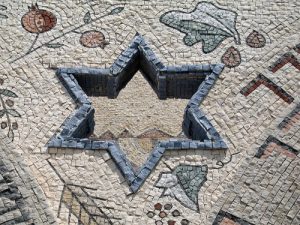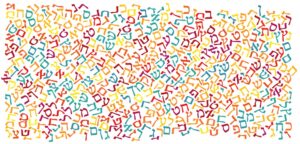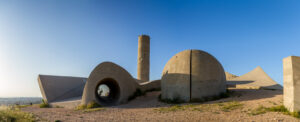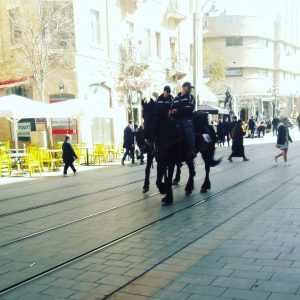Since the starting of the 20th century, visual arts in Israel became influenced by creative artistic orientations from East and West Europe and also from local artistic movements.

Indeed, Israeli arts are a blend of different cultures, both locals and Europeans, reflecting the character of the Land of Israel and the various cities of this beautiful country. Paintings, sculptures, photography, and architecture bring with them traits of the Israeli landscape and nature, assimilating and blending elements from Europe. The stunning variety of the Israeli landscapes was and is an inspiration for many artists. Among the fantastic panoramas of Israel, there are hill terraces and ridges with unique lines and shapes such as the foothills of the Negev, the general greyish-green plants, and the bright glowing light exhibit as results peculiar colour effects; additionally, the sea and sand of Israel are incredibly unique. In general, regional landscapes, affairs, and politics prevail in Israeli art, making it absolutely amazing.
The Beginning Of Israeli Art
Coordinated art movements in Israel began in 1906 when Professor Boris Schatz arrived in Israel from Bulgaria and created the Bezalel Academy of Arts and Crafts in Jerusalem. The foundation of the Bezalel Academy was possible thanks to a plan approved at the 1905 Zionist Congress to support gifted young Jews to study art in the Land of Israel. By 1910, the school included 32 different departments, a group of 500 students, and a ready business concerning its artworks involving the entire Jewish world.
Besides painting and sculpture, the country’s artistic life includes many artisans who bring art to life every day in Israel. In Israel, several talented craftspeople, such as ceramicists, silver and goldsmiths, weavers, calligraphers, glass blowers, and much more, practice art with different modern interpretations of traditional Jewish ritual objects.

Most Israelis are very enthusiastic regarding art and, the State of Israel supports artistic activities, financing exhibitions and curating all the museums. Indeed, it is a habit for Israelis to attend art exhibitions – from one-artist retrospectives to large group shows at the country’s many museums and private galleries, especially visiting the artists’ quarters of Safed and Yafo or the artists’ village of Ein Hod, where it is also possible to purchase the artworks of local artists.
Israeli Painting
In the beginning, Bezalel’s artistic orientation, which intended to create an “original Jewish art” by combining European techniques with Middle Eastern elements. The results were paintings of biblical scenes portraying romanticised attitudes of antiquity connected to romantic concepts of the future, with depicted images of the ancient Jewish Eastern communities and the local Bedouins.

The famous artists of this period were Shmuel Hirszenberg, Ephraim Lilien, and Abel Pann. The first significant art exhibition held at David’s Citadel in Jerusalem’s Old City was overshadowed by painters from Bezalel Academy. Shortly after that, Bezalel’s anachronistic and national-oriental style was disputed both by young innovators within the Bezalel institution and by lately arrived artists, who started seeking an expression appropriate to them labelled as “Hebrew” contrary to the concept of “Jewish” art. In an attempt to define their original artistic personality and display their view of Israel as a source of national rebirth, they portrayed the daily reality of the Middle Eastern environment, emphasising the bright light and glowing colours of the landscape and highlighting exotic topics such as the daily Arab lifestyle, employing mainly an ancient technique, as observed in the artworks of painters such as Israel Paldi, Tziona Tagger, Pinhas Litvinovsky, Nahum Gutman, and Reuven Rubin. Since the mid-decade of the last century, most of the principal artists were based in the new and vibrant city of Tel Aviv, which has endured to be the centre of the artistic activities of Israel. The art of the 1930s was heavily affected by early 20th-century Western discoveries; among them, the most powerful was the expressionism arising in the ateliers of Paris. The artworks of painters such as Moshe Castel, Menachem Shemi, and Arie Aroch favoured the portrayal of an emotional world, frequently interpreted as a mystical reality using distortion. And although themes were still about regional landscapes and portraits, the narrative elements dating back years earlier disappeared with the time, and the oriental-Muslim world disappeared completely.

Elements from German expressionism were introduced with the arrival of immigrant artists escaping the horror of rising Nazism. These immigrants joined the group directed by German-born artists Anna Ticho and Leopold Krakauer, who had moved to Jerusalem about 20 years earlier. This artistic group included Hermann Struck, Mordechai Ardon, and Jakob Steinhardt, and it was devoted mainly to personal descriptions of the landscape of Jerusalem and its surrounding hills. These artists contributed significantly to the growth of Israeli art, prominently thanks to the leadership provided to the Bezalel Academy of Art by the two directors, Ardon and Steinhardt, who guided a new generation of artists. During World War II, the separation from Paris and the trauma of the Holocaust induced several artists such as Moshe Castel, Yitzhak Danziger, and Aharon Kahana to embrace the innovative ‘Canaanite’ ideology. This new ideology ventured to find an identity with the local inhabitants of the land of Israel, creating a group of “new Hebrew people” by restoring ancient myths and pagan motifs.
During the 1948 War of Independence, other artists such as Naftali Bezem and Avraham Ofek embraced an activist style expressing a distinct social message. The most important group created in this period was the “New Horizons” one, which aimed to detach Israeli art from its regional character, introducing it into the circle of contemporary European art.
Two significant artistic trends developed: Yosef Zaritzky, the group’s principal personage, pointed towards a mysterious lyricism marked by identifiable components of the local landscape and cool colour hues. His style was adopted by Avigdor Stematsky and Yehezkel Streichman. The second trend was a stylised abstractionism varying from geometricity to symbolism. It was evident in the artworks of the Romanian artist Marcel Janco, who was one of the founders of Dadaism in Paris. The New Horizons group created abstract art in Israel and was also its dominant team until the early 1960s. Artists of the 1960s contributed to creating a link between the activities of the New Horizons group and an individual artistic trait in the next decade. Streichman and Stematsky, who were both teachers at the Avni Institute in Tel Aviv, completely inspired the second generation of artists such as Raffi Lavi, Aviva Uri, Uri Lifschitz and Lea Nikel. These artists sought personal symbolism and confronted abstractionism’s elegant brushwork, including various expressive and symbolic abstract techniques.These artists formed “The Group of Ten,” founded in the late 1950s, disputing against the prevailing artistic universalism. Their purpose was addressing art subjects towards the Israeli landscape and Israeli people. Unlike the elite European atmosphere encompassing the New Horizons group, the Group of Ten found its identity in the native Israeli ‘Sabra’ and the Palmah generation. During the 1960s, realist artists Ori Reisman and Yitzhak Mambush joined the Group of Ten. Additionally, at Bezalel Academy, Ardon’s influence in motifs and techniques was evident in the artworks of Avigdor Arikha, who produced a typology of art that overflowed with deep spirituality, also adding figurative subjects reminiscent of the Holocaust and traditional Jewish topics, like in the surrealistic paintings of Yossl Bergner and Samuel Bak. Jacob Agam expressed a radically different style, and he was such a pioneer in optic and kinetic art that his work has been exhibited both in Israel and abroad. In the 1970s, in Israel, whilst minimalist art most of the time included amorphic and transparent patterns evocative of abstractionism, the exhibit of concepts dominated the aesthetics of the artworks of artists such as Larry Abramson and Moshe Gershuni.
Between the 1980s and 1990s, artists created in an ambience of personal experimentation. They wanted Israel’s intrinsic spirit by combining an extensive range of materials, techniques, and images from Israeli and general elements such as the Hebrew alphabet letters and human emotions. Modern artistic inclinations, which are visible in the artworks of Pinhas Cohen-Gan, Deganit Beresht, Gabi Klezmer, Tsibi Geva, Tzvi Goldstein, and David Reeb, continue to aim to an extension of Israeli art beyond its traditional concepts and conventional materials, making it a unique expression of the indigenous culture including also progressive elements of the contemporary Western art.

Israeli Sculpture
Sculpture prospered in Israel thanks to the efforts of some sculptors such as Avraham Melnikoff, who is known for his massive stone lion at Tel Hai, and Ze’ev Ben-Zvi, who introduced cubism.
Moshe Ziffer, Aharon Priver and Batya Lishansky, who managed the department before the establishment of the State of Israel, represented the academic school of sculpture. In the last part of the 1940s, the “Canaanite” movement influenced several artists; among them, the most notable was Yitzhak Danziger, who created a figure of the pagan hero Nimrod, which was carved from red Nubian sandstone, combining elements from the Middle Eastern sculpture and the modern concepts of the human body.
In the 1950s, the statues were created using new materials on a monumental scale. Indeed, sculptures became increasingly abstract because of the modern introduction of iron and Cor-Ten steel as sculptural materials.
The purpose of producing concrete memorials for the heroes who fell in Israel’s wars introduced a new impetus in the Israeli sculpture starting from the 1960s. Indeed, in those years, prominent non-figurative monuments were created in Israel. An example is the welded steel naval memorial at Achziv by Yehiel Shemi, which blends nature’s harshness and human violence and destruction.
Another sculpture’s masterpiece is Dani Karavan’s “Monument to the Negev Brigade” outside Beer Sheva, which evokes the unique spirit of desert endurance.

The French school and expressionism in particular influenced Israeli art, which employed a variety of materials. Contemporary artists created sculptures to represent their responses to socio-political realities by using unique shapes and symbols. The artworks of provocative Israel Prize winner Yigal Tumarkin display his remonstrance against war through geometric and symbolic abstract designs. On the other side, the geometric minimalism of Menashe Kadishman continued to use sheep images, which recalls the ram in the biblical sacrifice of Isaac as a mythological symbol of a helpless victim.

Various Israeli sculptors have attained international recognition, including Tumarkin, Karavan, Kosso Elul, and Israel Hadany, whose artworks are displayed in different galleries and museums abroad.
Israeli Photography
Photography in Israel approaches personal subjects such as life, death, art and illusions, and the national-political elements. It is characterised by closeness, self-control, and amusement with the self, both a reaction to and an outgrowth of the romantic, informational style that dominated its early development stages. In the mid-19th century, Israeli photography essentially provided photographic services, focusing on holy places, such as Christian ones, to sell them as souvenirs to pilgrims and tourists.

Since 1880, photographers started to document the evolution of the Jewish community in the Land of Israel, depicting Israelis working the land and building cities through a modern and secular philosophy, which was also a requirement of clients who commissioned their pictures. Hence, many gifted photojournalists documented Israel’s improvement; among them, the most notable are David Harris, Micha Bar-Am, Tim Gidal, David Rubinger, Werner Braun, Boris Carmi, and Zev Radovan.
The photography in Israel includes “photography as documentation” and “art photography”, examples are Aliza Auerbach, who focuses on portraiture; Neil Folberg, Doron Horwitz and Shai Ginott, whose subject is nature; David Darom, a skilful underwater photographer; Dubi Tal and Mony Haramati, who are specialised in aerial photography. Among the several photography venues in Israel, the most renowned are the photography biennale at Mishkan Le’Omanut in Kibbutz Ein Harod and the new Museum of Photography at Tel Hai in the northern Galilee. Recently, photography became a recognised art form, and numerous imaginative photographers appeared, thanks to the support of galleries, museums, curators, and collectors in Israel and overseas.

The most famous artistic photographer is Adi Nes, born in Kiryat Gat to a family of Kurdistan and Iran families. Nes became famous in the 1990s with his artwork “Soldiers”, a photographic series concerning the national identity and Israeli male identity. Another work of Adi Nes is “Bible Stories”, which evocates Biblical moments with a contemporary setting.
Another notable photographer is Barry Frydlender, who combines dozens, or hundreds, of photographs into a single image with accuracy, precision, and perspective. In 2007, in Tel Aviv Museum Of Art, there was an exhibition of its “Place and time”, featuring contemporary Israel pictures such as an all-male gathering in East Jerusalem, Haredi Jews on an annual pilgrimage, and the forced evacuation of Israeli settlers from the Gaza Strip. Afterwards, the exhibition moved to the Museum of Modern Art in New York, the first solo exhibition of an Israeli artist in MOMA.

